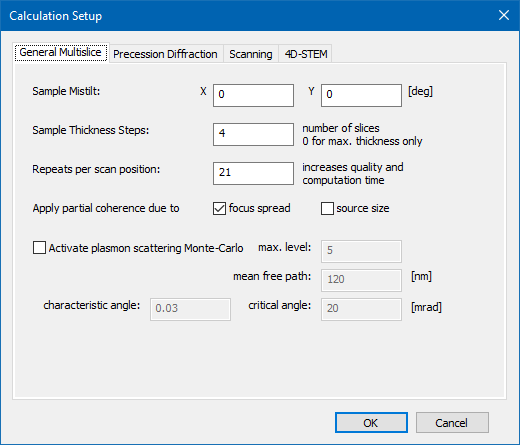|
|
GUI - Multislice Settings > Dr. Probe / Documentation / GUI / Calculation / Setup |

|
General multislice parameters may apply to all or a sub-set of the available simulation schemes.

Sample mistilt describes small deviations from the zone axis orientation realized by the atomic structure model. The additional tilt is specified here by two parameters in degrees, referring to the X and Y components of sample tilt in the coordinate system of the sample. An approximation is used describing the tilt by tilted free-space propagators [J.H.Chen et al., Acta Cryst. A 53 (1997) 576-589, doi:10.1107/S0108767397005539]. The approximation remains valid for small tilts in the range below 5 degrees.
Sample thickness steps define the step size of periodic detector readout over sample thickness, i.e. along the z axis, in number of structure slices. A step size of 1 would lead to a thickness series where images are extracted with each step of the multislice. With a step size of 2, images would be read out every second slice, etc. When setting the step size to 0 images will only be calculated for the maximum sample thickness of the simulation.
Repeats per scan position specify how often the multislice calculation is repeated at each scan position or for probe propagations and CBED simulations. With each multislice calculated with a different frozen lattice configuration of the sample, the number set here, determines the amount of frozen-lattice averaging. The calculation time will increase with more repetitions.
Switches for focus spread and source size toggle the simulation of partial spatial coherence:
- Scan image simulations, apply the focus spread by explicit averaging if the option is checked here. In this case, each scan pixel needs to be re-calculated with at least the number of focal kernel samples specified in the basic illumination setup. The source size is applied by convolution after the simulation and requires only small additional time.
- Simulations of probe propagation and CBED patterns apply both partial coherence effects by explicit averaging using a Monte-Carlo variation of probe defocus and probe shift. A sufficient number of samples is required especially for representing the 2-dimensional source distribution. The number Monte-Carlo samples is set by the number of Repeats per scan position discussed above. Use 100 or more samples when simulating source size effects.
Activating plasmon scattering Monte-Carlo will introduce additional beam tilts to simulate low-angle scattering in the sample. This strategy effectively implements the approach of B. Mendis [Ultramic. 206 (2019) 112816, doi:10.1016/j.ultramic.2019.112816 ] applying local beam tilts instead of sample tilts. The Monte-Carlo requires 4 input parameters:
- The maximum number of excitations determines how many inelastic scattering events are allowed for each electron while passing through the whole sample.
- The mean free path for plasmon excitations in nanometers.
- The characteristic angle (mrad) determines the width of the Lorentzian distribution of scattering angles and may be calculated by the fraction Ep/(2 E0), from plasmon energy Ep and primary electron energy E0.
- The critical angle (mrad) at which plasmon scattering breaks down. A rough approximation may be Sqrt(Ep/E0).
In order to achieve convergence of plasmon Monte-Carlo calculations a large amount of averaging should be used by setting a respectively large number of repeats per scan position.
Last update: April 14, 2022 contact disclaimer(de)